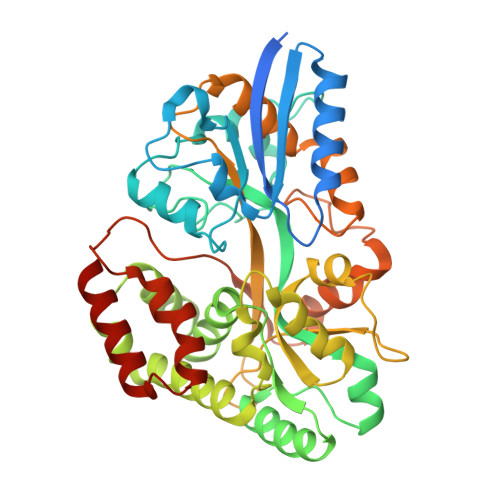Uptake of fucosylated type I human milk oligosaccharide blocks by Bifidobacterium longum subsp. infantis.
Ejby Hansen, M., Sakanaka, M., Jensen, M., Sakanaka, H., Pichler, M.J., Maeda, S., Franck Hovring, J., Nakajima, A., Kunstmann, S., Nielsen, T.S., Peters, G.H.J., Slotboom, D.J., Morth, J.P., Katayama, T., Abou Hachem, M.(2025) mBio 16: e0036825-e0036825
- PubMed: 40657901
- DOI: https://doi.org/10.1128/mbio.00368-25
- Primary Citation of Related Structures:
9H0N, 9H0O, 9H0P - PubMed Abstract:
Human milk oligosaccharides (HMOs) are uniquely rich in the type 1 building block disaccharide lacto- N -biose I (LNB; Galβ1,3GlcNAc), as compared to other mammals. Most HMOs are fucosylated, for example, α1,2 and α1,4 fucosylations on LNB blocks, resulting in H type 1 (H1) and Lewis a (Le a ) epitopes, respectively. The dominance of Bifidobacterium in breastfed infant guts hinges on the efficient uptake of HMOs by specific ATP-binding cassette (ABC) importers. However, molecular insight into uptake of fucosylated LNB blocks is lacking. Here, we analyzed the uptake of LNB and its fucosylated H1 and Le a trisaccharides, as well as the mucin-derived disaccharide galacto- N -biose (GNB; Galβ1,3GalNAc) by an ABC importer from the HMO-utilization specialist Bifidobacterium longum subsp. infantis . Structural analyses and molecular dynamics simulations explained how fucosylated and non-fucosylated LNB forms are recognized with similar affinities by the binding protein of this importer. Strikingly, we showed that two ABC importers confer to the uptake of LNB, while the Le a trisaccharide is efficiently internalized by a single importer in B. infantis . Phylogenetic and structural analyses of bifidobacterial ABC-associated binding proteins showed that the Le a clade harbors homologs possessing internal cavities, which allows for the accommodation of branched oligosaccharides. Our work provides unique insight into the evolution and molecular basis of capture and uptake of key HMO and host-derived saccharide blocks, highlighting these compounds as hitherto unexplored candidates for fortification of infant formula. The assembly of the gut microbiota in early life is critical to the health trajectory of human hosts. Breast feeding selects for a Bifidobacterium -rich community, adapted to efficiently utilize human milk oligosaccharides (HMOs) from mother's milk. Industrial scale production of HMOs for infant formula fortification has mainly considered fucosyllactoses, whereas fucosylated type 1 HMO blocks have hitherto not been explored. Our work sheds light on the uptake facet, central to the utilization of fucosylated HMOs with type 1 LNB building blocks. These type I blocks are efficiently internalized and assimilated by B. infantis , which has been recently shown to secrete immune-modulatory aromatic-lactate metabolites that mediate immune-priming of hosts in early life. This study contributes to our understanding of the utilization of HMOs and highlights fucosylated LNB blocks, as hitherto unexplored prebiotic candidates that support the growth of B. infantis and other beneficial gut bacteria in early life.
- Department of Biotechnology and Bioengineering, Technical University of Denmark, Lyngby, Denmark.
Organizational Affiliation:



















